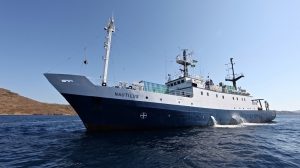Live Feed from the E/V Nautilus of a Bubbling Hydrocarbon Plume, “The Sleeping Dragon”
– July 18, 2014
A rare opportunity for the public to watch scientists do research in real time is happening right now at nautiluslive.org/live/channel-2, with live video being streamed from the Exploration Vessel Nautilus.
Dr. Scott Socolofsky with Texas A&M University and Dr. Chip Breier with Woods Hole Oceanographic Institution, both members of the Gulf Integrated Spill Research (GISR) consortium, are on board the E/V Nautilus. They are at the Mississippi Canyon 118 site (MC118) just north of the Deepwater Horizon site to study the natural seep MC118 – dubbed “the sleeping dragon” – using equipment about 900 meters below the sea surface.
They are analyzing the evolution and interaction of hydrocarbon gases as they bubble up and travel through the water column. Using a Remotely Operated Vehicle (ROV), they are taking pictures of gas bubbles and collecting samples for analysis. At 6 PM tonight, they will deploy an Acoustic Doppler Current Profiler (ADCP) to directly measure velocity of the seeping gas. The live video feed will switch to the ROV operation during the dive phase of the cruise. A CTD is installed on the ROV to look at basic physical oceanographic parameters as well as dissolved oxygen, chlorophyll and chromophoric dissolved organic matter. Data from their analyses will ultimately help to better understand and predict the fundamental behavior of petroleum and other hydrocarbon fluids in the ocean environment.
Viewers can observe ship-board activities such as the maneuvering of equipment and instruments at the seafloor and can also submit questions to scientists on duty. Unlike most other vessels available for academic research, the E/V Nautilus is equipped with a high-bandwidth satellite system, enabling remote science and education through the Inner Space Center (ISC) at the University of Rhode Island’s Graduate School of Oceanography. From there, the live feeds are shared with Exploration Command Consoles that are located worldwide.
Read more about this research at the GISR website.
************
This research was made possible in part by a grant from BP/The Gulf of Mexico Research Initiative (GoMRI) to the Gulf Integrated Spill Response (GISR) consortium. The GoMRI is a 10-year independent research program established to study the effect, and the potential associated impact, of hydrocarbon releases on the environment and public health, as well as to develop improved spill mitigation, oil detection, characterization and remediation technologies. An independent and academic 20-member Research Board makes the funding and research direction decisions to ensure the intellectual quality, effectiveness and academic independence of the GoMRI research. All research data, findings and publications will be made publicly available. The program was established through a $500 million financial commitment from BP. For more information, visit https://gulfresearchinitiative.org/.
© Copyright 2010-2017 Gulf of Mexico Research Initiative (GoMRI) – All Rights Reserved. Redistribution is encouraged with acknowledgement to the Gulf of Mexico Research Initiative (GoMRI). Please credit images and/or videos as done in each article. Questions? Contact web-content editor Nilde “Maggie” Dannreuther, Northern Gulf Institute, Mississippi State University (maggied@ngi.msstate.edu).






